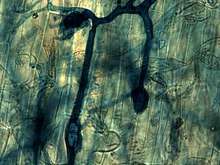Rhizophagus irregularis
Rhizophagus irregularis (previously known as Glomus intraradices[3][4]) is an arbuscular mycorrhizal fungus used as a soil inoculant in agriculture and horticulture. In addition, it is one of the best mycorrhizal varieties of fungi available to mycoforestry, but as it does not produce fruiting bodies it "has virtually no market value as an edible or medicinal mushroom"[5]
| Rhizophagus irregularis | |
|---|---|
 | |
| mycorrhized roots of Vicia faba with Rhizophagus irregularis | |
| Scientific classification | |
| Kingdom: | Fungi |
| Division: | Glomeromycota |
| Class: | Glomeromycetes |
| Order: | Glomerales |
| Family: | Glomeraceae |
| Genus: | Rhizophagus |
| Species: | R. irregularis |
| Binomial name | |
| Rhizophagus irregularis (Błaszk., Wubet, Renker & Buscot) C. Walker & A. Schüßler 2010[1] | |
| Synonyms[2] | |
| |
Rhizophagus irregularis is also commonly used in scientific studies of the effects of arbuscular mycorrhizal fungi on plant and soil improvement.
Until 2001, the species was known and widely marketed as Glomus intraradices, but molecular analysis of ribosomal DNA led to the reclassification of all arbuscular fungi from Zygomycota phylum to the Glomeromycota phylum.[6]
Description
Spores
Identification
Rhizophagus irregularis colonization peaks earlier than many of the other fungi in the Glomus genus. There tends to be extensive hyphal networking and intense intraradical spores associated with older roots of host plants.
At times the spores are densely clustered or patchily distributed, depending on the host species. When the spores are heavily clustered, mycorrhizologists and others will tend to mistake G. intraradices for G. fasciculatum.[7]
Reproduction
Rhizophagus irregularis (previously known as Glomus intraradices) has been found to colonise new plants by means of spores, hyphae or fragments of roots colonized by the fungus [8]
Ecology and distribution
Distribution
Rhizophagus irregularis can be found in almost all soils, especially those populated with common host plants and in forests and grasslands.
This is a brief list of some common host plants. Most agricultural crops will benefit from Rhizophagus irregularis inoculation. Generally host plants must be vascular plants, but not always.[9]
Conservation and status
Rhizophagus irregularis is not in danger of becoming extinct; however, most damage is caused by chemicals and tillage.
Relevance
R. irregularis is known to colonize nearly all important commercial crops including rice, corn, soybean, wheat, cannabis, hemp, and alfalfa.
In numerous scientific studies G. intraradices has been shown to increase phosphorus uptake in multiple plants as well as improve soil aggregation due to hyphae.[16]
Because of these qualities, G. intraradices is commonly found in mycorrhizal based fertilizers.
In a recent study, G. intraradices was found to be the only arbuscular mycorrhizal fungi that was able to control nutrient uptake amounts by individual hyphae depending on differing phosphorus levels in the surrounding soil.[12]
References
- "Rhizophagus irregularis (Arbuscular mycorrhizal fungus) (Glomus intraradices)". www.uniprot.org.
- "Rhizophagus irregularis" (html). MycoBank. Retrieved 30 April 2019.
- "Home - Rhizophagus irregularis DAOM 181602 v1.0". genome.jgi.doe.gov.
- Stockinger, H.; Walker, C.; Schußler, A. (2009). "'Glomus intraradices DAOM197198', a model fungus in arbuscular mycorrhiza research, is not Glomus intraradices". New Phytol. 183 (4): 1176–87. doi:10.1111/j.1469-8137.2009.02874.x. PMID 19496945.
- Stamets, P. (2005). Mycelium Running: How Mushrooms Can Help Save the World
- Krüger, Manuela; Claudia Krüger; Christopher Walker; Herbert Stockinger; Arthur Schüßler (2012). "Phylogenetic reference data for systematics and phylotaxonomy of arbuscular mycorrhizal fungi from phylum to species level". New Phytologist. 193 (4): 970–984. doi:10.1111/j.1469-8137.2011.03962.x. PMID 22150759.
- Morton, J, & R Amarasinghe. Glomus intraradices.International Culture Collection of (Vesicular) Arbuscular Mycorrhizal Fungi. 2006. West Virginia University. 17 November 2009. http://invam.caf.wvu.edu/index.html.
- Klironomos, JN; Hart, MM (Aug 2002). "Colonization of roots by arbuscular mycorrhizal fungi using different sources of inoculum". Mycorrhiza. 12 (4): 181–4. doi:10.1007/s00572-002-0169-6. PMID 12189472.
- Peterson, R, H Massicotte, L Melville (2004). Mycorrhizas: Anatomy and Cell Biology. NRC Research Press, Ottawa: 7-8.
- Toro M, Azcon R, Barea J (November 1997). "Improvement of Arbuscular Mycorrhiza Development by Inoculation of Soil with Phosphate-Solubilizing Rhizobacteria To Improve Rock Phosphate Bioavailability ((sup32)P) and Nutrient Cycling". Applied and Environmental Microbiology. 63 (11): 4408–12. PMC 1389286. PMID 16535730.
- Duponnois, R; Colombet, A; Hien, V; Thioulouse, J (2005). "the mycorrhizal fungus Glomus intraradices and rock phosphate amendment influence plant growth and microbial activity in the rhizosphere of Acacia holosericea". Soil Biology & Biochemistry. 37 (8): 1460–1468. doi:10.1016/j.soilbio.2004.09.016.
- Cavagnaro, T; Smith, F; Smith, S; Jakobsen, I (2005). "Functional diversity in arbuscular mycorrhizas: exploitation of soil patches with different phosphate enrichment differs among fungal species". Plant, Cell and Environment. 28 (5): 642–650. doi:10.1111/j.1365-3040.2005.01310.x.
- Augé, R; Stodola, A; Tims, J; Saxton, A (2000). "Moisture retention in a mycorrhizal soil". Plant and Soil. 230: 87–97. doi:10.1023/a:1004891210871.
- Cavagnaro, T; Jackson, L; Six, J; Ferris, H; Goyal, S; Asami, D; Scow, K (2005). "Arbuscular mycorrhizas, microbial communities, nutrient availability, and soil aggregates in organic tomato production". Plant and Soil. 282 (1–2): 209–225. doi:10.1007/s11104-005-5847-7.
- Requena, N; Perez-Solis, E; Azcón-Aguilar, C; Jeffries, P; Barea, J (2000). "Management of indigenous plant-microbe symbioses aids restoration of desertified ecosystems". Applied and Environmental Microbiology. 67 (2): 495–498. CiteSeerX 10.1.1.334.4707. doi:10.1128/aem.67.2.495-498.2001. PMC 92612. PMID 11157208.
- Cardoso, Irene M.; Kuyper, Thomas W. (2006). "Mycorrhizas and tropical soil fertility". Agriculture, Ecosystems & Environment. 116 (1–2): 72–84. doi:10.1016/j.agee.2006.03.011.
External links
- Formey D, Molès M, Haouy A, et al. (December 2012). "Comparative analysis of mitochondrial genomes of Rhizophagus irregularis - syn. Glomus irregulare - reveals a polymorphism induced by variability generating elements". The New Phytologist. 196 (4): 1217–27. doi:10.1111/j.1469-8137.2012.04283.x. PMID 22967288.
- JGI Mycorrhizal Genomics Initiative on Rhizophagus irregularis DAOM 181602 v1.0
| Wikispecies has information related to Rhizophagus irregularis |